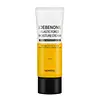What's inside
What's inside
 Key Ingredients
Key Ingredients

 Benefits
Benefits

 Ingredients Side-by-side
Ingredients Side-by-side

Water
Skin ConditioningGlycerin
HumectantButylene Glycol
HumectantHydrogenated Lecithin
EmulsifyingSucrose
HumectantGlucose
HumectantFructose
HumectantBeta-Glucan
Skin ConditioningHydroxydecyl Ubiquinone
AntioxidantSorbitol
HumectantErythritol
HumectantXanthan Gum
EmulsifyingHydrogenated Polyisobutene
EmollientCaprylic/Capric Triglyceride
MaskingTocopherol
AntioxidantDipotassium Glycyrrhizate
HumectantAllantoin
Skin ConditioningEthylhexylglycerin
Skin ConditioningPropanediol
SolventChamaecyparis Obtusa Branch/Leaf Extract
HumectantWater, Glycerin, Butylene Glycol, Hydrogenated Lecithin, Sucrose, Glucose, Fructose, Beta-Glucan, Hydroxydecyl Ubiquinone, Sorbitol, Erythritol, Xanthan Gum, Hydrogenated Polyisobutene, Caprylic/Capric Triglyceride, Tocopherol, Dipotassium Glycyrrhizate, Allantoin, Ethylhexylglycerin, Propanediol, Chamaecyparis Obtusa Branch/Leaf Extract
Water
Skin ConditioningGlycerin
HumectantDipropylene Glycol
HumectantButylene Glycol
HumectantTrehalose
HumectantBetaine
HumectantCetyl Ethylhexanoate
EmollientDicaprylyl Carbonate
EmollientCentella Asiatica Extract
CleansingProtease
ExfoliatingPanthenol
Skin ConditioningMoringa Oleifera Seed Extract
Skin ConditioningAloe Barbadensis Leaf Extract
EmollientPropanediol
SolventGlyceryl Polyacrylate
Dipotassium Glycyrrhizate
HumectantAllantoin
Skin ConditioningXanthan Gum
EmulsifyingSaussurea Involucrata Extract
HumectantRubus Chamaemorus Fruit Extract
AntioxidantSelaginella Lepidophylla Extract
EmollientTropolone
Skin ConditioningSodium Polyacryloyldimethyl Taurate
Emulsion StabilisingSodium Polyacrylate
AbsorbentHydrogenated Polydecene
EmollientCaprylic/Capric Triglyceride
MaskingTrideceth-10
CleansingCaprylhydroxamic Acid
1,2-Hexanediol
Skin ConditioningBoswellia Serrata Resin Extract
SmoothingBrassica Oleracea Italica Extract
AstringentLithospermum Erythrorhizon Root Oil
Skin ConditioningBioflavonoids
Skin ConditioningGeranium Maculatum Oil
MaskingWater, Glycerin, Dipropylene Glycol, Butylene Glycol, Trehalose, Betaine, Cetyl Ethylhexanoate, Dicaprylyl Carbonate, Centella Asiatica Extract, Protease, Panthenol, Moringa Oleifera Seed Extract, Aloe Barbadensis Leaf Extract, Propanediol, Glyceryl Polyacrylate, Dipotassium Glycyrrhizate, Allantoin, Xanthan Gum, Saussurea Involucrata Extract, Rubus Chamaemorus Fruit Extract, Selaginella Lepidophylla Extract, Tropolone, Sodium Polyacryloyldimethyl Taurate, Sodium Polyacrylate, Hydrogenated Polydecene, Caprylic/Capric Triglyceride, Trideceth-10, Caprylhydroxamic Acid, 1,2-Hexanediol, Boswellia Serrata Resin Extract, Brassica Oleracea Italica Extract, Lithospermum Erythrorhizon Root Oil, Bioflavonoids, Geranium Maculatum Oil
 Reviews
Reviews

Ingredients Explained
These ingredients are found in both products.
Ingredients higher up in an ingredient list are typically present in a larger amount.
Allantoin is a soothing ingredient known for its protective and moisturizingg properties. Because of this, it is often added to products with strong active ingredients.
Studies show higher concentrations of this ingredient can promote wound healing.
Though it can be derived from the comfrey plant, allantoin is produced synthetically for cosmetic products to ensure purity.
Learn more about AllantoinButylene Glycol (or BG) is used within cosmetic products for a few different reasons:
Overall, Butylene Glycol is a safe and well-rounded ingredient that works well with other ingredients.
Though this ingredient works well with most skin types, some people with sensitive skin may experience a reaction such as allergic rashes, closed comedones, or itchiness.
Learn more about Butylene GlycolThis ingredient is an emollient, solvent, and texture enhancer. It is considered a skin-softener by helping the skin prevent moisture loss.
It helps thicken a product's formula and makes it easier to spread by dissolving clumping compounds.
Caprylic Triglyceride is made by combining glycerin with coconut oil, forming a clear liquid.
While there is an assumption Caprylic Triglyceride can clog pores due to it being derived from coconut oil, there is no research supporting this.
Learn more about Caprylic/Capric TriglycerideDipotassium Glycyrrhizate comes from licorice root.
Extracts of licorice have demonstrated to have antibacterial, anti‐inflammatory, antiviral, antioxidant properties.
One component, glabridin, has extra potent antioxidant and soothing properties. It has also been found to block pigmentation from UVB rays in guinea pigs.
Licorice Root also contains a flavonoid. Flavonoids are a natural substance from in plants. Flavonoids also have antioxidant properties.
Another component, glycyrrhizin, has been found to have anti-inflammatory and antimicrobial benefits. This may make licorice root extract effective at treating acne. However, more research is needed to support this.
Liquiritin is one of the flavone compounds found in licorice. It has been found to help lighten skin by preventing tyrosinase from reacting with tyrosine. When the two react, protein is converted to melanin. Melanin is the substance in your body that gives your features pigmentation.
Licorice root is native to Southern Europe and Asia. It has been used in traditional Chinese medicine to help with respiratory issues.
Learn more about Dipotassium GlycyrrhizateGlycerin is already naturally found in your skin. It helps moisturize and protect your skin.
A study from 2016 found glycerin to be more effective as a humectant than AHAs and hyaluronic acid.
As a humectant, it helps the skin stay hydrated by pulling moisture to your skin. The low molecular weight of glycerin allows it to pull moisture into the deeper layers of your skin.
Hydrated skin improves your skin barrier; Your skin barrier helps protect against irritants and bacteria.
Glycerin has also been found to have antimicrobial and antiviral properties. Due to these properties, glycerin is often used in wound and burn treatments.
In cosmetics, glycerin is usually derived from plants such as soybean or palm. However, it can also be sourced from animals, such as tallow or animal fat.
This ingredient is organic, colorless, odorless, and non-toxic.
Glycerin is the name for this ingredient in American English. British English uses Glycerol/Glycerine.
Learn more about GlycerinPropanediol is an all-star ingredient. It softens, hydrates, and smooths the skin.
It’s often used to:
Propanediol is not likely to cause sensitivity and considered safe to use. It is derived from corn or petroleum with a clear color and no scent.
Learn more about PropanediolWater. It's the most common cosmetic ingredient of all. You'll usually see it at the top of ingredient lists, meaning that it makes up the largest part of the product.
So why is it so popular? Water most often acts as a solvent - this means that it helps dissolve other ingredients into the formulation.
You'll also recognize water as that liquid we all need to stay alive. If you see this, drink a glass of water. Stay hydrated!
Learn more about WaterXanthan gum is used as a stabilizer and thickener within cosmetic products. It helps give products a sticky, thick feeling - preventing them from being too runny.
On the technical side of things, xanthan gum is a polysaccharide - a combination consisting of multiple sugar molecules bonded together.
Xanthan gum is a pretty common and great ingredient. It is a natural, non-toxic, non-irritating ingredient that is also commonly used in food products.
Learn more about Xanthan Gum